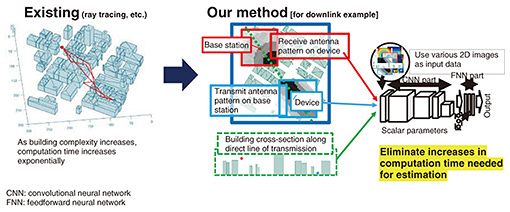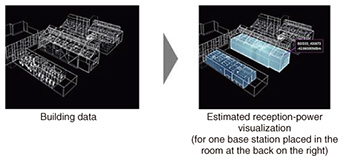 |
|||||||||||||
|
|
|||||||||||||
|
Feature Articles: Keynote Speeches and R&D on Access Networks Presented at Tsukuba Forum 2024 Vol. 22, No. 10, pp. 54–59, Oct. 2024. https://doi.org/10.53829/ntr202410fa6 Wireless Technology Supporting People to Live a Fulfilling Social LifeAbstractNTT laboratories are engaged in the research and development (R&D) on wireless communication technologies to meet various requirements for the wireless devices, communication schemes, applications, and usage scenarios that are diversifying as we enter the 6G (sixth-generation mobile communication system)/IOWN (Innovative Optical and Wireless Network) era. This article introduces NTT’s Cradio®, which embodies a set of multi-radio proactive control technologies, and related advanced R&D technologies. Keywords: 6G, wireless access, Cradio® 1. Wireless access in the 6G/IOWN eraThe Innovative Optical and Wireless Network (IOWN), which is a network and information processing infrastructure concept centered on optical technology and able to provide high-speed, high-capacity communications and massive computational resources, has been advocated as a model for next-generation networks. The wireless access component can be developed in the following directions (Fig. 1).
2. Advanced wireless accessAs the need for using wireless access increase rapidly, cultivation of radio-frequency bands suitable for wide-band use (legalization) and standardization of wireless formats are progressing to maximize use of radio waves, which are a public resource. Directions for development of wireless formats are shown in Fig. 2. Currently, wireless formats in wide use can be divided mainly into cellular radio (3G, 4G, 5G), which assumes public use, guaranteed connectivity, and high reliability for users, and independent formats such as Wi-Fi, which can provide high maximum throughput but only provide best-effort rates that fluctuate due to surrounding usage conditions and interference. Both have advanced year-after-year. In the coming 6G era of cellular radio, user requirements for consumer and business solutions will become integrated, resulting in demand to provide a wireless access environment that satisfies all requirements by intelligently using both wireless formats. Regarding Wi-Fi standardization, high reliability is currently entering the scope of discussion for next-generation Wi-Fi. NTT laboratories’ members have been appointed to important positions and are actively participating in discussion. Regarding further advances in cellular, millimeter-wave and other high-frequency bands are being cultivated and technology verification to enable stable utilization is becoming increasingly important. NTT laboratories are collaborating with NTT DOCOMO and various manufacturers to promote technical verification for 6G [1].
We are also developing technologies using the latest standardized functions. Figure 3 shows an example of a low-latency, high-reliability technology using an unlicensed band with multi-link operation, which is part of next-generation Wi-Fi. Starting with Wi-Fi 7, a function of multi-link operation is introduced, enabling devices and access points (APs) equipped with multiple wireless interfaces to communicate using them simultaneously, but flow control linking each wireless interface as an approach to reduce latency was not implemented. Thus, we have achieved low latency by executing flow control that combines background traffic data, including data across all wireless interfaces, with wireless layer congestion information.
As the frequency of bands used is increased, the effect of obstacles will increase, making the conditions for estimating the areas reached by radio waves more complex and the computation time required to estimate signal propagation will increase. NTT laboratories therefore developed an original estimation method using machine learning. The method enables us to estimate reception power over a large area quickly by using deep learning with simple input data such as antenna patterns, cross-sections of buildings, and the height of surrounding buildings (Fig. 4).
3. Network provision following changes in the environmentFor network provision that follows changes in the environment, NTT laboratories are conducting research and development (R&D) on Cradio®, which is a multi-radio proactive control technology consisting of a set of technologies to enable a natural user experience without requiring them to be aware of the wireless access system, even when multiple wireless access systems are combined [2]. Cradio® links three technologies that understand, predict, and control the wireless communications environment, enabling various wireless networks to follow changes in the environment or communication state and adapt before changes occur. Cradio® can use a wide range of data beyond data that it can obtain from wireless access systems, such as map data and building data that can be obtained by linking with digital space platforms, external services, social systems, and other external databases, to maximize the potential of wireless access systems. This can also increase value by seamlessly linking with existing business systems (Fig. 5).
The understanding technology uses advanced analysis of the information available from wireless communication systems to understand communication-quality conditions (congestion, device usage, interference) for each end user and device. We are also investigating using the wireless data obtained with this technology for “deviceless sensing” to estimate device location and understand changes in surrounding buildings and other objects that can affect the wireless environment. The prediction technology uses deep learning to predict wireless communication quality, as it changes due to the surrounding environment and device position, on the basis of wireless quality information obtained with the understanding technology. This enables degradation to be detected in wireless communication quality beforehand, proactively controlling devices and applications, and making adjustments such as switching to a better-quality network or changing the transmission rate for transmitting video. The control technology is a dynamic design and control technology for wireless access networks that follows network design and operating requirements on the basis of information from the understanding and prediction technologies. For example, it can design a wireless communication area dynamically on the basis of propagation estimation for the planned types of base station and antenna characteristics, or use the function for estimating wireless quality at the link layer for each wireless method to compute and control parameters of wireless devices, and implement network design and operation that avoids local congestion. Effort on projects using Cradio® has been making progress. I introduce a trial conducted by NTT WEST and Takenaka Corporation. In this trial, Cradio® was used with 3D building information modeling (BIM), and the following was evaluated regarding whether the wireless environment could be estimated accurately and efficiently after construction was completed [3].
As a result, the median error when comparing the estimated and measured values for reception power was less than 5 dB, the design time for wireless-LAN base-station positioning when using simulation was 30% less than when using conventional methods, and the equipment placement design by simulation can reduce the amount of equipment used by 50% than the design with conventional methods. We next introduce verification of real-time cooperative control in accordance with usage state for optical paths and wireless access (Fig. 7). In this verification, a Wi-Fi AP was connected to an IOWN All-Photonics Network (APN) line to simulate a wireless environment in a factory, and an environment was built in which devices connected to the Wi-Fi AP communicated with a cloud server. For the first time, a wireless controller implementing Cradio® functions that understand wireless usage state was linked to a controller able to switch at the optical path level on an IOWN APN line, using the extended Cooperative Transport Interface (eCTI) specified by the IOWN Global Forum [4]. This will enable uses such as a factory using Wi-Fi, where the Cradio® understanding function can detect when the number of user devices and amount of application traffic changes suddenly, and on the basis of this information, automatically switch the optical path connecting the application to the server. Testing has confirmed that such cooperative operations can be completed in around 100 ms.
4. Supporting people to live a fulfilling social life with wireless technologyIn addition to the technical development to provide a network that follows advancements in wireless access and changes in the environment, discussion on how to use new access networks is very important. For example, NTT DOCOMO’s 6G white paper [5] identifies use cases to address social issues, for human-object communication, to expand the communications environment, and advance cyber-physical integration. NTT DOCOMO is developing a haptic sharing technology called FEEL TECH® and the Human Augmentation Platform [6]. Many factors, such as body, sensation, and emotion, can be conveyed and shared through this platform, which could lead to entirely new unforeseen use cases. We believe it is important to continue study, both to advance R&D, and discover new use cases to support people to live a fulfilling social life with wireless technology. References
|
|||||||||||||








